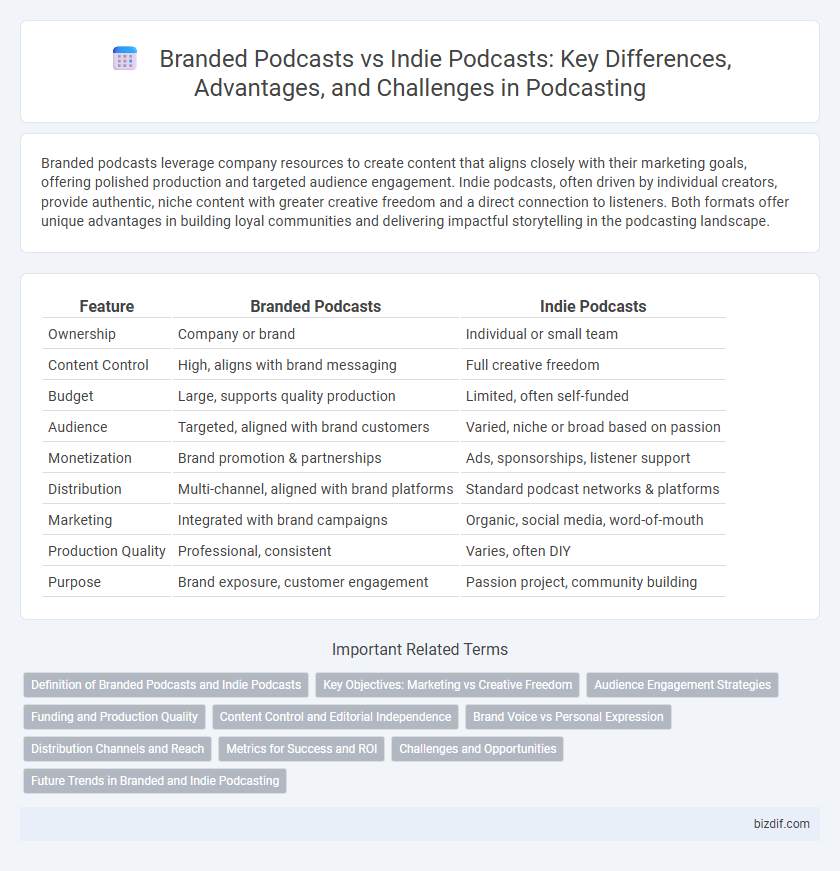Branded podcasts leverage company resources to create content that aligns closely with their marketing goals, offering polished production and targeted audience engagement. Indie podcasts, often driven by individual creators, provide authentic, niche content with greater creative freedom and a direct connection to listeners. Both formats offer unique advantages in building loyal communities and delivering impactful storytelling in the podcasting landscape.
Table of Comparison
| Feature | Branded Podcasts | Indie Podcasts |
|---|---|---|
| Ownership | Company or brand | Individual or small team |
| Content Control | High, aligns with brand messaging | Full creative freedom |
| Budget | Large, supports quality production | Limited, often self-funded |
| Audience | Targeted, aligned with brand customers | Varied, niche or broad based on passion |
| Monetization | Brand promotion & partnerships | Ads, sponsorships, listener support |
| Distribution | Multi-channel, aligned with brand platforms | Standard podcast networks & platforms |
| Marketing | Integrated with brand campaigns | Organic, social media, word-of-mouth |
| Production Quality | Professional, consistent | Varies, often DIY |
| Purpose | Brand exposure, customer engagement | Passion project, community building |
Definition of Branded Podcasts and Indie Podcasts
Branded podcasts are audio series produced by companies or organizations primarily to promote their brand, products, or services while engaging a targeted audience through storytelling and marketing strategies. Indie podcasts, on the other hand, are independently created by individual hosts or small teams, focusing on niche topics, personal expression, or community building without direct commercial sponsorship. The distinction lies in intent and funding, with branded podcasts serving marketing goals and indie podcasts emphasizing creative freedom and listener connection.
Key Objectives: Marketing vs Creative Freedom
Branded podcasts prioritize marketing objectives by aligning content with brand messaging to enhance consumer engagement and drive sales. Indie podcasts emphasize creative freedom, allowing hosts to explore niche topics and unique storytelling without commercial constraints. Both approaches serve distinct purposes: branded podcasts leverage audience reach and brand loyalty, while indie podcasts foster authentic connection and innovation in content creation.
Audience Engagement Strategies
Branded podcasts leverage targeted content marketing and integrated advertising to build loyal audiences by aligning episodes with the brand's values and consumer interests, often utilizing data analytics to refine engagement strategies. Indie podcasts foster authentic connections through niche storytelling and community-driven interactions on platforms like Patreon and Discord, encouraging direct listener feedback and collaboration. Combining multimedia promotion and personalized listener experiences enhances audience retention and deepens emotional investment across both branded and indie formats.
Funding and Production Quality
Branded podcasts typically benefit from substantial funding provided by companies or sponsors, enabling access to high-end production equipment, professional studios, and experienced audio engineers, which enhances overall sound quality and consistency. Indie podcasts often rely on limited budgets, with creators managing both content and production, resulting in variable audio quality but greater creative freedom and authenticity. Investment levels directly influence the scale of marketing efforts and production values, making branded podcasts more polished, while indie productions prioritize unique storytelling and niche audience engagement.
Content Control and Editorial Independence
Branded podcasts prioritize content control by businesses or sponsors, ensuring alignment with marketing goals and brand messaging while often limiting editorial independence. Indie podcasts enjoy greater freedom to explore diverse topics, voice authentic perspectives, and engage niche audiences without external pressures or commercial constraints. This editorial independence fosters creativity and authenticity, attracting listeners seeking genuine, uncensored content.
Brand Voice vs Personal Expression
Branded podcasts strategically amplify a company's brand voice through consistent messaging tailored to target audiences, strengthening brand identity and customer loyalty. Indie podcasts prioritize personal expression, allowing hosts to explore niche topics and authentic storytelling without constraints from corporate guidelines. Balancing brand voice with personal authenticity is crucial in podcasting, as it influences listener engagement and perceived credibility.
Distribution Channels and Reach
Branded podcasts leverage established distribution channels such as corporate websites, social media platforms, and email newsletters to target specific customer segments, ensuring broad and targeted reach. Indie podcasts primarily rely on popular podcast directories like Apple Podcasts, Spotify, and Google Podcasts, utilizing organic growth and word-of-mouth to expand their listener base. The scalability of branded podcasts often outpaces indie shows due to access to marketing budgets and cross-channel promotion opportunities.
Metrics for Success and ROI
Branded podcasts typically leverage extensive marketing budgets and audience analytics to track ROI through metrics like listener engagement, conversion rates, and brand awareness growth. Indie podcasts prioritize organic growth and community-building, often measuring success via listener loyalty, episode downloads, and social media interaction. Both formats use metrics such as average listen duration and subscriber growth to evaluate impact, but branded podcasts tend to have more precise monetization benchmarks linked to broader marketing goals.
Challenges and Opportunities
Branded podcasts face challenges such as maintaining authentic audience engagement while aligning content with corporate messaging and navigating potential creative restrictions imposed by brand guidelines. Indie podcasts encounter opportunities to build niche communities and exercise creative freedom, although they often struggle with limited budgets and marketing resources. Both formats benefit from evolving digital platforms that offer advanced analytics and monetization options to optimize reach and revenue.
Future Trends in Branded and Indie Podcasting
Branded podcasts are increasingly leveraging targeted data analytics and immersive storytelling to enhance audience engagement and deliver measurable marketing ROI. Indie podcasts continue to thrive through authentic content creation, niche community building, and innovative monetization strategies like crowdfunding and merchandise sales. Future trends indicate a convergence where branded and indie podcasts adopt hybrid models, utilizing AI-driven personalization and cross-platform distribution to expand reach and listener loyalty.
Branded podcasts vs indie podcasts Infographic

 bizdif.com
bizdif.com